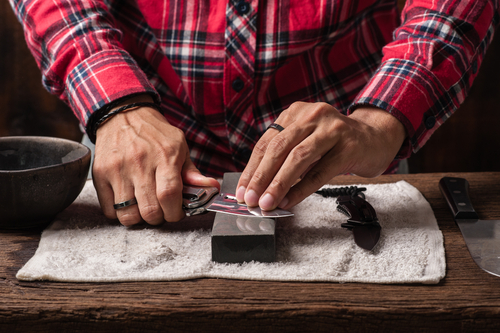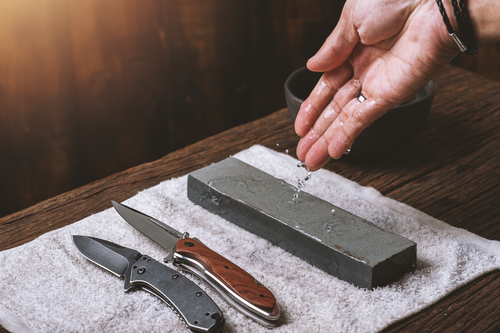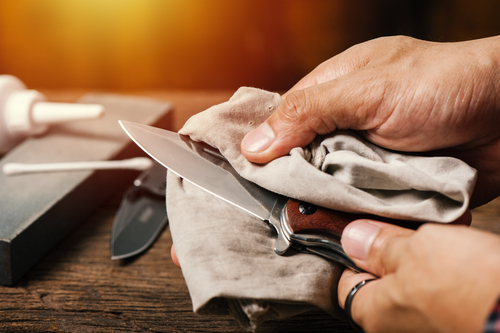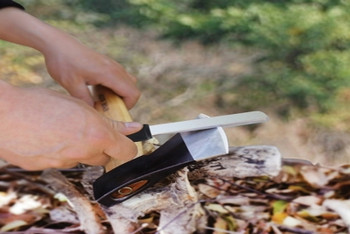How to Sharpen a Pocket Knife
Nov 22nd 2018

A dull knife blade not only affects the performance but can also be downright dangerous. Today’s modern pocket knife blades are generally made from high-tech steel, which can hold its edge for longer but, at some point during the life of your pocket knife, you will need to sharpen it.
Maintaining your knife is important to prolong the life and performance of the blade, so, to make sure that your blade is always sharp when you need it, here is our guide on how to sharpen your pocket knife.
Tools You Need to Sharpen a Pocket Knife
To get a wickedly sharp pocket knife blade, all you need are two simple tools for the job: a whetstone and lubricant.
Whetstone
The whetstone is what does most of the work when sharpening a blade. At the very basic level, a whetstone is a simple sharpening stone that has two different levels of grit: rough and fine. The rough side is used to grind the metal from the blade, while the fine surface is used to hone the blade.
There are hundreds of different types of whetstones available, including diamond-encrusted stones, water stones, and ceramic stones. The one you choose depends on your blade type and your preference.
Lubricant
Lubricant is necessary to compensate for the heat that is produced from the friction between the blade and the whetstone. Excessive heat can damage and warp the blade, affecting the performance.
During the sharpening process, a small amount of metal debris called swarf also builds up, and the lubricant helps to remove this from the blade to allow for more effective sharpening.
Most lubricants are oil-based, but you can also use water, depending on the sharpening stone you have. Some stones do not require any lubricant, so check the instructions when purchasing your whetstone.

Step-by-Step Guide to Sharpen a Pocket Knife
1. Before you begin sharpening, clean the knife properly with mild soap and warm water.
2. Check which side has the rough grit by gently dragging your thumbnail along the surface of the stone. You start the sharpening process on the rough grit side first.
3. Prepare the whetstone by pouring a generous amount of lubricant over the surface of the stone. Don’t drench the stone; it should be just enough to cover it with a thin film.
4. Lay the knife blade flat on the rough surface of the whetstone, then raise it to a 15-degree angle. Different knife blades may require different sharpening angles. Most standard EDC pocket knives can be sharpened at an angle between 10-15 degrees. Steeper sharpening angles can give you a sharper blade, but the blade will not hold its edge for as long. If in doubt, check the user’s manual for the blade angle on your knife.
5. Holding the knife at the correct angle, apply moderate pressure to the blade and drag the blade along the whetstone toward you, as though you are carving off a small slice from the stone. Alternatively, you can drag the blade away from you, depending on what is more comfortable. Repeat 10-15 times.
To tell if the other side of the blade is ready to be sharpened, feel for a burr, which is a small buildup of metal along the opposite side of the blade. Do this by running your thumbnail along the unsharpened side of the blade.
6. Flip the knife over and repeat the process on the other side of the blade. It is important to use an equal number of strokes for each side of the blade, to retain the bevel angle.
7. Perform another 10-12 additional strokes, this time alternating between each side of the blade.
8. Once you have a small burr on both sides of the blade, it's time to switch to the fine grit side of the stone to begin honing the blade. Repeat the steps above, making sure to keep consistent pressure throughout the sharpening process. By the time you have finished with the fine grit side, the burrs should be removed.

The Takeaway
Pocket knives are perfect for everyday, on-the-go use. Keep your EDC pocket knife in pristine condition with regular maintenance and a sharpening schedule so you will always have a razor-sharp blade when you need it. Also, learn the proper way to carry a folding knife, so that it will hold its new edge for longer. This may be in a sheath, a specially designed clip, or even a holster.
To learn more about knife maintenance and care, or to find out about the range of high-quality EDC knives we carry, call eKnives at (423)-525-9477 to talk with our experienced staff.

